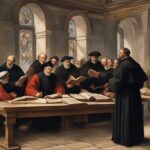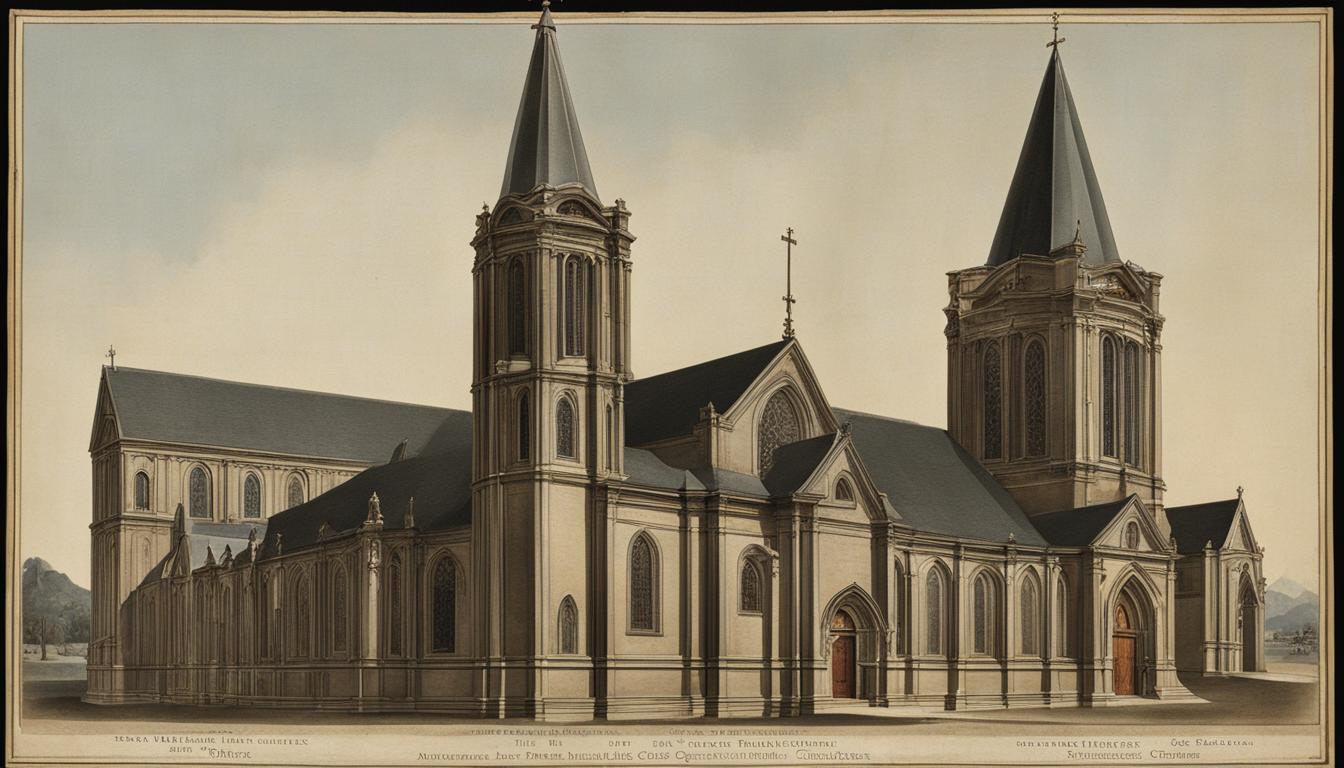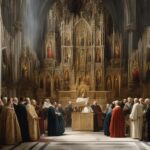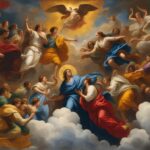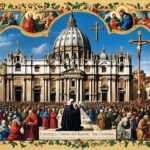Welcome to our comprehensive guide on the English Reformation, a transformative period in English history that saw the break with the Catholic Church and the establishment of Protestantism in England. Led by King Henry VIII, this historic event had a lasting impact on English society, culture, and religious identity. Join us as we explore the key figures, causes, and consequences of the English Reformation, and delve into the development of the Church of England, the Dissolution of the Monasteries, and the cultural and literary impact of this significant historical event.
Key Takeaways:
- The English Reformation was initiated by King Henry VIII and marked the break with the Catholic Church.
- The Dissolution of the Monasteries was a significant consequence of the Reformation, leading to the redistribution of church property.
- The English Reformation played a crucial role in the development of Anglicanism and the Church of England.
- Key figures such as Thomas Cranmer and Thomas Cromwell shaped the course of the Reformation in England.
- The influence of the English Reformation extended beyond England, impacting global Christianity.
Causes of the English Reformation
The English Reformation was a complex and multifaceted event that had several key causes. One of the primary factors was King Henry VIII’s desire to annul his marriage to Catherine of Aragon. Henry wished to secure a male heir to the throne, but Pope Clement VII refused to grant the annulment. This disagreement led Henry to break with Rome and establish the Church of England, with himself as its head.
Another influential factor was the influence of the wider European Protestant Reformation. Protestant ideas were spreading across Europe, challenging the authority of the Catholic Church. These ideas, along with Henry’s infatuation with Anne Boleyn, contributed to the shaping of the English Reformation. Anne Boleyn, Henry’s second wife, was sympathetic to Protestant beliefs and had a significant impact on the religious and political landscape of England.
The causes of the English Reformation were thus a combination of personal, political, and religious factors. Henry VIII’s desire for an annulment, the refusal of the Pope, the influence of Protestant ideas, and the role of Anne Boleyn all played a significant role in shaping the course of the Reformation in England.
Key Figures of the English Reformation
The English Reformation was shaped by several key figures who played significant roles in its development and impact. These individuals, including King Henry VIII, Thomas Cranmer, Anne Boleyn, Edward VI, Mary I, Elizabeth I, and Thomas Cromwell, each contributed to the Reformation in different ways.
King Henry VIII, with his desire for an annulment and the establishment of the Church of England, was a central figure in initiating the English Reformation. His decision to break with Rome and establish himself as the head of the Church of England had profound consequences for the religious landscape of England.
King Henry VIII’s actions set the stage for the development of Anglicanism and the English Protestant Church.
Thomas Cranmer, as the Archbishop of Canterbury, played a crucial role in shaping the theology and liturgy of the Church of England. His work in developing the Book of Common Prayer and his influence on the religious practices of the time left a lasting impact on the direction of the Reformation in England.
Anne Boleyn, as Henry VIII’s second wife and the mother of Elizabeth I, also had a significant influence on the English Reformation. Her support of Protestant reformers and her promotion of reformist ideas within the court contributed to the spread of Protestantism in England.
Edward VI, Mary I, and Elizabeth I, all played critical roles in the succession of the English throne and the subsequent religious policies of their reigns. Edward VI, as a staunch Protestant, further advanced the cause of the Reformation in England during his short reign. Mary I, on the other hand, sought to restore Catholicism and suppress Protestantism during her reign. Finally, Elizabeth I’s reign saw the establishment of the Elizabethan Religious Settlement, which solidified the Church of England’s position as the official state religion.
Thomas Cromwell, as Henry VIII’s chief minister, played a crucial role in the Dissolution of the Monasteries and the confiscation of church property. His influence and administrative skills were instrumental in implementing the king’s religious policies and furthering the cause of the English Reformation.
These key figures of the English Reformation shaped the course of history in England and the development of Protestantism. Their actions and beliefs continue to influence religious practices and the cultural fabric of English society.
Dissolution of the Monasteries
One of the significant consequences of the English Reformation was the Dissolution of the Monasteries. Under the reign of Henry VIII, monastic institutions were dissolved, and their assets and properties were confiscated by the crown. This process aimed to weaken the power and influence of the Catholic Church, redistribute wealth, and promote the Protestant Reformation in England.
The Dissolution of the Monasteries had far-reaching effects on English society and the economy. The vast amount of Church property that was seized provided the crown with substantial resources. These properties, including land and valuable items, were confiscated and often sold, leading to a significant redistribution of wealth. The revenues generated from the sale of monastic lands also helped fund the crown’s military and economic endeavors, contributing to the consolidation of royal power.
“The monastic institutions were seen as symbols of Catholic authority and wealth, and their dissolution was a way for Henry VIII to assert his control over the Church and the nation.”
Furthermore, the Dissolution of the Monasteries had a profound impact on the religious landscape of England. With the dissolution of the monastic orders, religious practices and beliefs underwent significant changes. The traditional Catholic rituals and devotions associated with monastic life were replaced by Protestant worship and theology. The Dissolution of the Monasteries played a crucial role in the establishment of the Church of England and the consolidation of Protestantism in England.
| Impact of the Dissolution of the Monasteries | |
|---|---|
| Confiscation of Church Property | Significant wealth and resources were acquired by the crown, contributing to the consolidation of royal power. |
| Redistribution of Wealth | The sale of monastic lands and assets led to a redistribution of wealth within English society. |
| Promotion of Protestant Reformation | The Dissolution of the Monasteries played a vital role in the establishment of the Church of England and the advancement of Protestantism in England. |
| Transformation of Religious Practices | The dissolution resulted in the replacement of Catholic rituals and devotions with Protestant worship and theology. |

Influence of the English Reformation on Anglicanism
The English Reformation had a profound impact on the development of Anglicanism, the religious tradition associated with the Church of England. The Reformation theology and principles shaped the beliefs and practices of Anglicanism, including the emphasis on Scripture, justification by faith, and the priesthood of all believers.
The Book of Common Prayer, written by Thomas Cranmer, became a central liturgical text for Anglican worship, providing a standardized structure for religious services. It helped establish a sense of unity and shared identity among Anglicans. The Thirty-Nine Articles, a statement of faith, set the theological framework for the Church of England, clarifying its beliefs and distinguishing it from Catholicism and other Protestant denominations.
The influence of the English Reformation on Anglicanism is evident in its approach to worship, theology, and governance. Anglican churches adopt a liturgical style of worship, combining elements of Catholic and Protestant traditions. They also maintain a hierarchical structure, with bishops overseeing local churches. The English Reformation laid the foundation for the development of an autonomous and distinctive religious tradition, with Anglicanism evolving into a global communion with diverse cultural expressions.
Elizabethan Religious Settlement
The Elizabethan Religious Settlement was a pivotal moment in the history of the English Reformation. Enacted during the reign of Queen Elizabeth I, it aimed to establish religious stability in England by striking a delicate balance between Catholic and Protestant elements. The settlement solidified the Church of England as the official state religion, but also allowed for certain Catholic practices to continue, appeasing both factions to some extent.
At the heart of the Elizabethan Religious Settlement were two key acts: the Act of Supremacy and the Act of Uniformity. The Act of Supremacy, passed in 1559, declared Queen Elizabeth I as the supreme governor of the Church of England, reaffirming the break from Catholicism initiated by her father, Henry VIII. It granted Elizabeth the authority to appoint bishops and clergy, solidifying the monarch’s control over the English church.
The Act of Uniformity, passed alongside the Act of Supremacy, mandated the use of the Book of Common Prayer in worship. This standardized liturgical practices and helped to create a sense of unity within the Church of England. However, the Act of Uniformity also allowed some leeway for traditional Catholic practices, such as the use of vestments and certain rituals, in order to appease those who still held Catholic beliefs.
| Act | Description |
|---|---|
| Act of Supremacy | Declares Queen Elizabeth I as the supreme governor of the Church of England |
| Act of Uniformity | Mandates the use of the Book of Common Prayer in worship |
The Elizabethan Religious Settlement had a significant impact on England’s religious landscape. It helped to stabilize the country during a time of religious turmoil, and its compromises allowed for a measure of religious tolerance. The settlement also served to solidify the Church of England’s position as a distinct entity, separate from both Catholicism and other Protestant sects. This legacy has endured to this day, with the Church of England remaining the established church in England and playing a central role in the country’s religious and cultural identity.
Spread of English Protestantism
The English Reformation not only transformed the religious landscape of England but also had a significant impact on the spread of Protestantism. As the Church of England became the established church, various Protestant groups emerged, each with their own beliefs and practices. One such group was the Puritans, who sought to further reform the Church of England to purify it from what they saw as remnants of Catholicism. The Puritans played a crucial role in the spread of English Protestantism, advocating for a more fervent and devout form of worship.
Another group that emerged during this time was the Pilgrims. Dissatisfied with the level of religious freedom in England, the Pilgrims decided to embark on a journey to the New World in search of a place where they could practice their faith freely. They established colonies in what is now known as Plymouth, Massachusetts, and their actions influenced the development of Protestantism in America. The Pilgrims’ commitment to self-governance and religious freedom is evident in the Mayflower Compact, a governing document they signed upon their arrival in the New World.
Similarly, the Separatists, another group driven by a desire for religious freedom, played a crucial role in the spread of English Protestantism. Like the Pilgrims, they believed that the Church of England was too closely tied to Catholicism and sought to separate themselves from it. Many Separatists migrated to the Netherlands before eventually making their way to the New World, where they established their own communities and contributed to the growth of Protestantism in America.
The Protestant Legacy in the New World
The colonization efforts of the English in the New World had a profound impact on the spread of English Protestantism. The colonies founded by the Pilgrims and Separatists, along with other English settlers, became strongholds of Protestantism and played a vital role in shaping the religious landscape of America. The influence of these early English Protestant settlers can still be seen today, as Protestantism remains the dominant religious tradition in the United States.
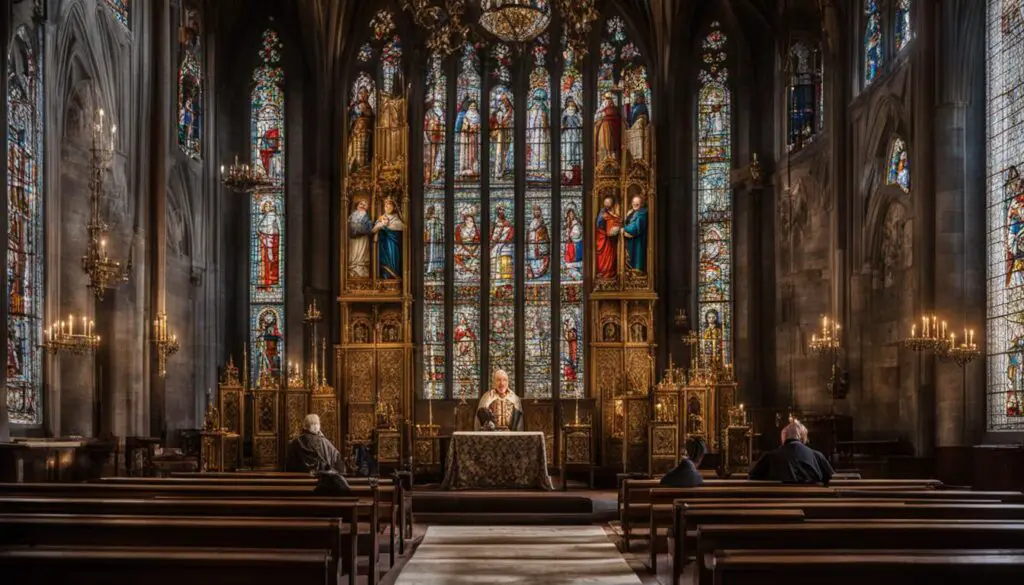
| English Protestant Groups | Key Beliefs and Practices |
|---|---|
| Puritans | Advocated for the purification of the Church of England, emphasized a strict moral code, and sought to create a more devout form of worship. |
| Pilgrims | Believed in the separation from the Church of England and sought religious freedom in the New World. Their commitment to self-governance and religious liberty is reflected in the Mayflower Compact. |
| Separatists | Rejected the Church of England entirely and sought to separate themselves from it. Many migrated to the Netherlands before establishing their own communities in the New World. |
The spread of English Protestantism in the New World brought with it a legacy of religious freedom, self-governance, and the influence of Protestant values on the development of American society. The Pilgrims, Separatists, and other English Protestant groups played a vital role in shaping the religious landscape of America and establishing the principles of religious liberty that continue to be celebrated today.
Legacy of the English Reformation
The English Reformation has left a lasting legacy on the religious, cultural, and social fabric of England. One of the most significant outcomes of the Reformation was the establishment of Protestantism as the dominant religious tradition in England, with the Church of England taking center stage. This religious shift has had a profound impact on English identity, shaping the beliefs, values, and practices of generations to come.
Religious pluralism is another important legacy of the English Reformation. The break with Rome and the subsequent Protestant influence paved the way for a more diverse religious landscape in England. While the Church of England became the established church, other Protestant denominations flourished, contributing to a rich tapestry of religious traditions and expressions.
The influence of the English Reformation extended well beyond England’s borders, shaping the development of global Christianity. The spread of Anglicanism, with its unique blend of Catholic and Protestant elements, influenced the growth of religious communities around the world. Anglican traditions made their way to colonies, establishing a lasting impact on the religious practices of diverse cultures and peoples.
The English Reformation not only transformed the religious landscape of England but also left an indelible mark on its cultural, literary, and artistic expressions. The use of English language in religious texts, such as the Bible and the Book of Common Prayer, helped solidify English as a literary language and fostered a sense of national identity. The Reformation also inspired the production of literature, art, and music with religious themes, influencing the cultural landscape of England.
| Legacy of the English Reformation | Description |
|---|---|
| Protestantism | The establishment of Protestantism as the dominant religious tradition in England, with the Church of England at its core. |
| Church of England | The Anglican church that has played a central role in English religious and cultural identity. |
| English identity | The English Reformation shaped the beliefs, values, and practices that define English identity today. |
| Religious pluralism | The Reformation opened the door to a diverse religious landscape in England, accommodating various Protestant denominations. |
| Influence on global Christianity | The Anglican traditions and practices influenced the development of religious communities worldwide. |
The legacy of the English Reformation is a testament to the far-reaching impact of religious and cultural transformations. It continues to shape the religious landscape, artistic expressions, and national identity of England, while also leaving an indelible mark on global Christianity.

Historical Significance of the English Reformation
The English Reformation holds significant historical importance due to its role in a broader wave of Reformation movements in Europe. It sparked religious conflicts and resulted in a shift in power dynamics, ultimately leaving a lasting impact on Europe and the monarchy. The break with Rome and the establishment of the Church of England marked a turning point in European history, as the power of the Catholic Church waned, and Protestantism gained prominence.
The English Reformation set off a series of religious conflicts as supporters of the Catholic Church and proponents of Protestantism clashed. These conflicts were not only theological but also political in nature, as they challenged the authority of the monarchy and sparked power struggles between different factions. The Reformation ultimately led to the establishment of the Church of England as the official state religion, solidifying the monarchy’s control over religious matters.
The impact of the English Reformation extended beyond England’s borders, influencing Europe as a whole. It contributed to the rise of Protestantism across the continent and prompted both religious and political reforms in various European countries. The Reformation challenged the authority of the Catholic Church, leading to the development of new religious denominations and a more diverse religious landscape.
“The English Reformation marked a significant turning point in European history and the development of religious and political institutions.”
Furthermore, the English Reformation had far-reaching consequences for the monarchy. By breaking with Rome and establishing the Church of England, English monarchs gained greater control over religious matters and solidified their authority as both political and religious figures. The Reformation brought about a significant shift in power dynamics, as the influence of the Catholic Church diminished, and the English Protestant Church grew in stature.
| Historical Significance of the English Reformation | Reformation movements | Religious conflicts | Shift in power dynamics | Impact on Europe | Impact on the monarchy |
|---|---|---|---|---|---|
| The English Reformation marked a significant turning point in European history and the development of religious and political institutions | The Reformation sparked religious conflicts as supporters of the Catholic Church and proponents of Protestantism clashed | The break with Rome and the establishment of the Church of England challenged the authority of the Catholic Church and led to power struggles | The English Reformation had a profound impact on Europe, contributing to the rise of Protestantism and prompting reforms in various countries | The Reformation resulted in a shift in power dynamics, as the authority of the monarchy grew with the establishment of the Church of England |
Cultural and Literary Impact of the English Reformation
The English Reformation had a profound cultural and literary impact on England. As the country transitioned from Catholicism to Protestantism, the themes and values of the Reformation became prominent in literature, art, and music.
Literature played a crucial role in reflecting and shaping the mindset of the English people during this transformative period. Writers such as William Tyndale, who translated the Bible into English, provided access to the Scriptures for the general population. The availability of religious texts in the vernacular language contributed to increased literacy rates and a flourishing of English literature. The Reformation themes of faith, salvation, and individual religious experience permeated the works of well-known writers like John Milton, who authored “Paradise Lost,” an epic poem exploring themes of sin and redemption.
Art and music were also profoundly influenced by the English Reformation. Protestant hymns, such as those written by Martin Luther and Isaac Watts, became an integral part of Protestant worship. These hymns, sung in vernacular languages, allowed congregations to actively participate in worship and express their faith. In the visual arts, religious paintings shifted from traditional Catholic iconography to reflect Protestant ideals. Artists like Hans Holbein the Younger depicted religious figures in a more realistic and humanistic style, reflecting the emphasis on individuality and the priesthood of all believers.
“The Reformation themes of faith, salvation, and individual religious experience permeated the works of well-known writers like John Milton, who authored ‘Paradise Lost,’ an epic poem exploring themes of sin and redemption.”
The English Reformation also fostered the development of literature in the English language. As the Church of England used English for its worship services, English became the primary language of religious texts and liturgy. This shift contributed to the growth of English as a literary language and the development of a distinct English literary tradition. The works of playwrights like William Shakespeare, whose plays often explored moral and religious themes, exemplify the influence of the English Reformation on the literary landscape.
In conclusion, the cultural and literary impact of the English Reformation cannot be overstated. It influenced the production of literature, art, and music, shaping the creative works of writers, artists, and musicians. The Reformation themes of faith, salvation, and individual religious experience became prominent in English literature, while Protestant hymns and a shift in artistic style reflected the changing religious landscape. The English Reformation also contributed to the development of literature in the English language, establishing English as a literary medium and paving the way for future literary masterpieces.
The English Reformation in Popular Culture and Education
The impact of the English Reformation extends beyond its historical significance, as it continues to captivate popular imagination and inspire various forms of artistic expression. From film and television to literature, the English Reformation has been a fascinating subject in popular culture. Its portrayal in these mediums allows audiences to engage with the complexities of religious, political, and cultural transformations that took place during this pivotal period in English history.
Films such as “A Man for All Seasons” and “Anne of the Thousand Days” have brought the drama and intrigue of the English Reformation to the big screen, capturing the personal struggles and political machinations of key figures like Thomas More and Anne Boleyn. Television series like “The Tudors” and “Wolf Hall” have further explored the intricate web of relationships and power dynamics that shaped the Reformation era.
In literature, the English Reformation has inspired countless works, both fictional and non-fictional. Novels like Hilary Mantel’s “Wolf Hall” and C.J. Sansom’s “Dissolution” transport readers back to the tumultuous world of Tudor England and provide vivid insights into the religious and political upheavals of the time. Historical biographies and academic studies also contribute to a deeper understanding of the English Reformation, offering diverse perspectives and interpretations.
Education plays a crucial role in fostering historical understanding and critical thinking skills, and the English Reformation is a key topic in history curricula around the world. Studying the Reformation enables students to explore the interplay between religion, power, and societal change, encouraging them to consider the far-reaching impact of historical events on individuals and communities. By engaging with the English Reformation in an educational setting, students develop a deeper appreciation for the complexities of this transformative period in English history.
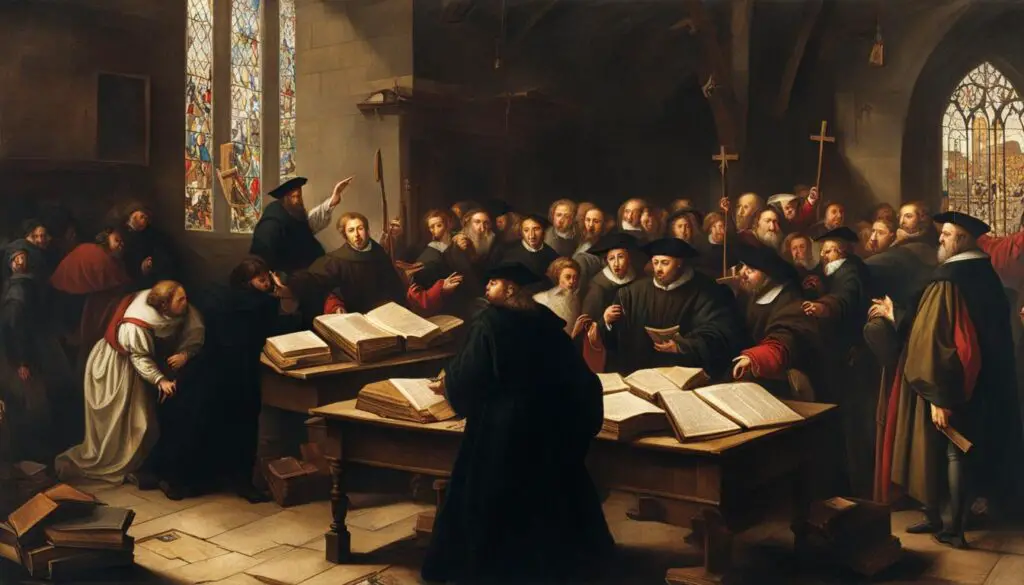
Conclusion
The English Reformation holds immense historical significance and has left a lasting legacy on English society and culture. This transformative period, initiated by King Henry VIII, led to the establishment of the Church of England, the Dissolution of the Monasteries, and the development of English Protestantism.
The Reformation not only shaped religious beliefs but also impacted the power dynamics within Europe and the English monarchy. It played a crucial role in the development of Anglicanism, with the Book of Common Prayer and the Thirty-Nine Articles becoming important theological and liturgical elements.
Beyond England, the English Reformation influenced the global spread of Protestantism, particularly through the establishment of colonies in the New World. Its cultural impact can be seen in literature, art, and music, with religious themes becoming prominent in creative works. Teaching the English Reformation in educational settings enables students to gain a deeper understanding of historical events and their significance.
In conclusion, the English Reformation holds its place as a pivotal moment in history. Its historical significance, lasting legacy, and cultural impact make it an essential subject of study for those seeking to understand the complexities of religious, political, and cultural transformations.
FAQ
What was the English Reformation?
The English Reformation was a transformative period in English history that saw the break with the Catholic Church and the establishment of Protestantism in England.
What were the causes of the English Reformation?
The main causes of the English Reformation were King Henry VIII’s desire for an annulment of his marriage to Catherine of Aragon and the influence of Protestant ideas from the broader European Protestant Reformation.
Who were the key figures of the English Reformation?
The key figures of the English Reformation include King Henry VIII, Thomas Cranmer, Anne Boleyn, Edward VI, Mary I, Elizabeth I, and Thomas Cromwell.
What was the Dissolution of the Monasteries?
The Dissolution of the Monasteries was the process of dissolving monastic institutions under Henry VIII, where their assets and properties were confiscated by the crown.
How did the English Reformation influence Anglicanism?
The English Reformation had a profound impact on the development of Anglicanism, shaping its beliefs, practices, and the establishment of the Church of England.
What was the Elizabethan Religious Settlement?
The Elizabethan Religious Settlement was a series of laws enacted during the reign of Elizabeth I that established the Church of England as the official state religion and sought religious stability.
How did the English Reformation spread Protestantism?
The English Reformation led to the spread of Protestantism within England and beyond, with various Protestant groups seeking to further reform the Church of England and some migrating to the New World.
What is the legacy of the English Reformation?
The English Reformation has had a lasting impact on English society, culture, religious identity, and the development of Anglicanism. It also influenced global Christianity through the spread of Anglicanism.
What was the historical significance of the English Reformation?
The English Reformation marked a significant turning point in European history, with implications for religious conflicts, shifts in power dynamics, and the development of religious and political institutions.
What was the cultural and literary impact of the English Reformation?
The English Reformation influenced the production of literature, art, and music, with religious themes becoming prominent. It also fostered the development of literature in the English language.
How is the English Reformation depicted in popular culture and education?
The English Reformation is frequently depicted in popular culture through film, television, and literature. It is also an important topic in education, providing insights into history, politics, religion, and cultural transformations.
What is the conclusion of the English Reformation?
The English Reformation was a pivotal moment in English history, with far-reaching consequences. Its study and understanding provide valuable insights into religious, political, and cultural transformations and their historical significance.
Source Links
- https://newgrowthpress.com/christian-books/pastoral-resources-books/reformation-worship-liturgies-from-the-past-for-the-present/
- https://www.onslow.k12.nc.us/site/handlers/filedownload.ashx?moduleinstanceid=115449&dataid=117496&FileName=ELA_5th_Grade_OCS_Priority_Standards_Unpacked_Content_CKLA_ Alignment_2021.pdf
- https://journals.openedition.org/pipss/5242


